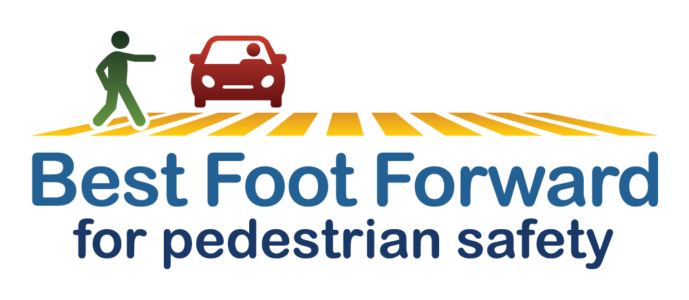ORLANDO, FL – As students throughout Central Florida prepare for a return to the classroom,…

Low-Cost Improvement Gets Quick Results
Walking home with heavy shopping bags in-hand, you approach an upcoming intersection. Cars are approaching in the distance, but the crosswalk is clearly marked for pedestrians. On a two-lane street near a shopping plaza, you’d expect drivers would anticipate people crossing. After all, Florida law requires drivers to yield to pedestrians at all crosswalks and street corners. But as you step into the road, the oncoming cars don’t stop—they whiz right by, darting around you while blaring their horn.
Even two-lane roads can be dangerous to cross when drivers expect you to stay on the sidewalk.
That was the problem in Casselberry, where only 12% of drivers were yielding to pedestrians at W. Melody Ln & S. Cypress Way, according to data collected by the Best Foot Forward (BFF) program throughout the past year. By March, the driver yield rate hit an all-time low of just 4%, despite the crosswalk being marked with special emphasis stripes and an adjacent pedestrian crossing sign.

To fix this problem, the City of Casselberry tried a simple engineering solution: a “gateway” in-street sign treatment with an accompanying stop bar painted on the road. And early results have been impressive: Data collections from the month of May show that since its installation, drivers have been yielding to pedestrians at the Melody & Cypress crosswalk a whopping 71% of the time—a major improvement.
“Yield rates above 70% are typically more common after the installation of Rectangular Rapid-Flashing Beacons,” according to Vince Dyer, program manager of Best Foot Forward. “But this is one of the largest leaps in yield rate we’ve ever recorded over a three month period.” By comparison, RRFB’s at similar two-to-three-lane crosswalks have an average yield rate of 73% this year, based on the same data collected by BFF around Central Florida.
And here’s the kicker—it’s a relatively low-cost solution to pedestrian safety. “We can do ten of these [gateway in-street treatments] for the cost of one RRFB,” according to Kelly Brock, traffic engineer with the City of Casselberry. Brock recently served as keynote speaker of the Wheel of Achievement awards, which recognizes engineering improvements in bicycle and pedestrian safety around Central Florida. The Wheel of Achievement Awards were hosted by Bike/Walk Central Florida, which administers the Best Foot Forward Program.

Gateway in-street sign treatments can be made more effective with special emphasis crosswalk stripes and stop bars painted on the road, which are low-cost solutions that Casselberry also deployed at the Melody and Cypress intersection. Lower speeds and fewer driving lanes increase the effectiveness of these measures on driver yield rate—factors that should be considered for any cities looking to make similar improvements.
Pedestrians have a right to cross streets safely and responsibly, and increasing the visibility of crosswalks in this way communicates to drivers that roads are meant to be shared.




This Post Has 0 Comments